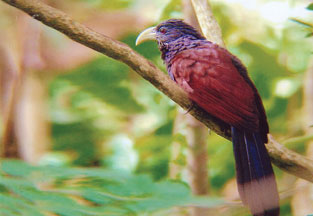Green-billed Coucal: threatened with extinction
by K. G. H. Munidasa
One morning a previous week I was up at six and seated in the
verandah with the pair of binoculars in my hand.
 The first bird to call was the Indian Pitta or "Avichchiya", and then
a White-breasted Kingfisher in the distance. Next the Orange-breasted
Blue-Flycatcher broke into song at 6.30 in the back yard, as usual. The first bird to call was the Indian Pitta or "Avichchiya", and then
a White-breasted Kingfisher in the distance. Next the Orange-breasted
Blue-Flycatcher broke into song at 6.30 in the back yard, as usual.
In spite of the overnight rains, the day turned out to be bright and
many birds began to vocalize around the house. As the rays of the sun
touched the tree tops, I focused the binoculars on the Champak
"Gini-Sapu" tree standing hardly 30 yards from the verandah. A pair of
Pompadour Green Pigeons were already there searching for ripen
pale-brown fruits, relished by many birds which regularly visit the
garden.
Barbets
There were several Brown-headed and Yellow-fronted Barbets, busy
selecting the fruits of their choice, and a solitary Crimson-breasted
Barbet or Coppersmith. Soon a pair of Green Imperial Pigeons and a
Ceylon Grey Hornbill arrived, dispersing all other feasters.
My attention was drawn to an unfamiliar bird-call in a tree fifty
yards away to my right. It was an Ebony or "Kuluwara" with clusters of
dark green leaves, growing adjacent to a leafy Jak tree.
The call poo-hoop characteristically similar to that of the commoner
Common Crow-Pheasant, familiar bird in most home gardens in the low
country, continued for about ten minutes. I failed to spot the strange
caller however much I tried, and finally saw a black bird with bright
chestnut back flying off from the opposite direction.
I jotted down a note in my field book and set about referring the
bird literature in my book shelf. After perusing the observations of
many an authority on the subject of Lankan bird species. I could fix my
chance sighting only on the Green-billed Coucal or "Batta Attikukula",
an endangered species.
If I would quote the Annotated Checklist (1978 Revised Edition), the
Ceylon Coucal Centropus chlororhynchus Blyth has been first described
from Avissawella in Western Province, Sri Lanka in 1849. The Author, W.
W. A. Phillips adds "Local but resident, in small numbers, in the
jungles and dense bamboo and cane-brakes of the Wet Zone, and
intermediate areas and ascends the Hills on the south-western slopes to
altitudes of 2,500 feet."
Records
According to the Ceylon Bird Club records, Green-billed Coucal is a
very sly and elusive bird far better known by its calls than by sight,
whose range is rapidly dwindling, and if no remedial measures are taken
there can be no doubt that its days will soon be numbered.
Similar to the common species, only rather smaller and slighter, the
gloss on the breast, hind-neck and upper back purplish and bronze; the
wings darker chestnut.
The feathers on the crown are longer and looser. Bill pale apple
green and the irides deep red or dull crimson.
Thy cry is a sonorous-hooo-poop, hooo-poo-poop- the poop being
lower-pitched.
Up to end of the last century this rare species has more often been
recorded from the Sinharaja Man and Biosphere Reserve, Peak Wilderness
(Adam's Peak) Sanctuary, Gilimale Forest, Ingiriya Forest Reserve
(Bodhinagala), Hakgala, Kanneliya and Hiniduma to mention a few.
Instances of breeding or nesting of the Green-billed Coucal was not
recorded from any of these localities until 1997, when a party of club
members who visited Sinharaja in September that year came across a nest
and a fledgling of this coucal at a place called Mulawella, outside the
main forest.
The nest was reportedly placed within the crown of a small tree
covered with creepers amidst thick growth of bamboo (Batta), about 10 to
12 feet from the ground, not properly hidden in the foliage.
The young coucal had left the nest and was waiting on a nearby
branch.
Its tail was very short and the back was black as in the young of the
Common Coucal.
However, a bit of purplish sheen visible on neck suggested that it
was not of the latter species. As they watched an adult Green-billed
Coucal came up and fed the young.
In April 1998, another party recorded a pair with a young at a forest
patch in the Sinharaja.
The adults perched separately, 6-8 feet from the ground. On closer
approach the young crept into the forest, led by the adults, and made a
"Chewick" - "Chewick" note. |

